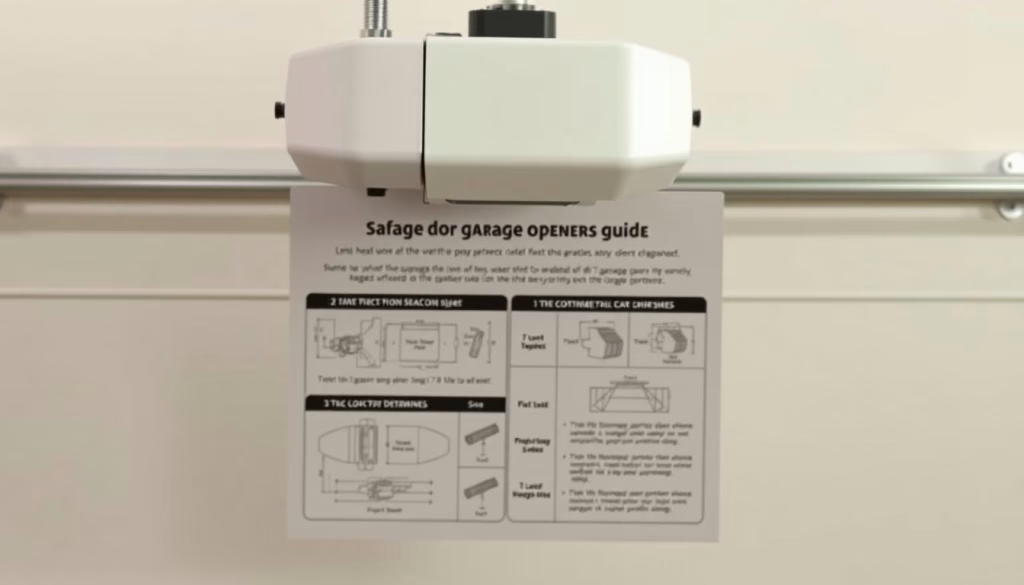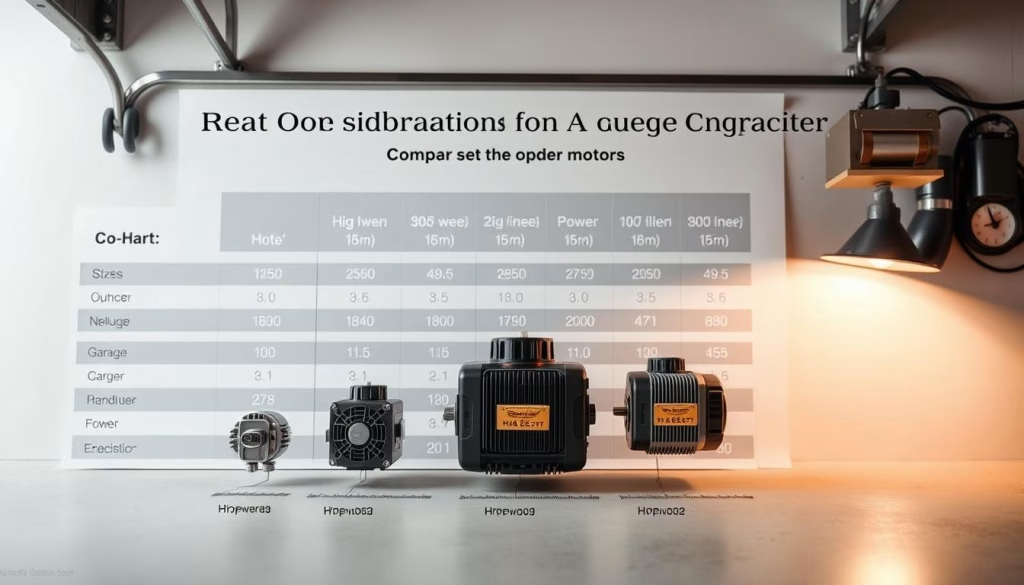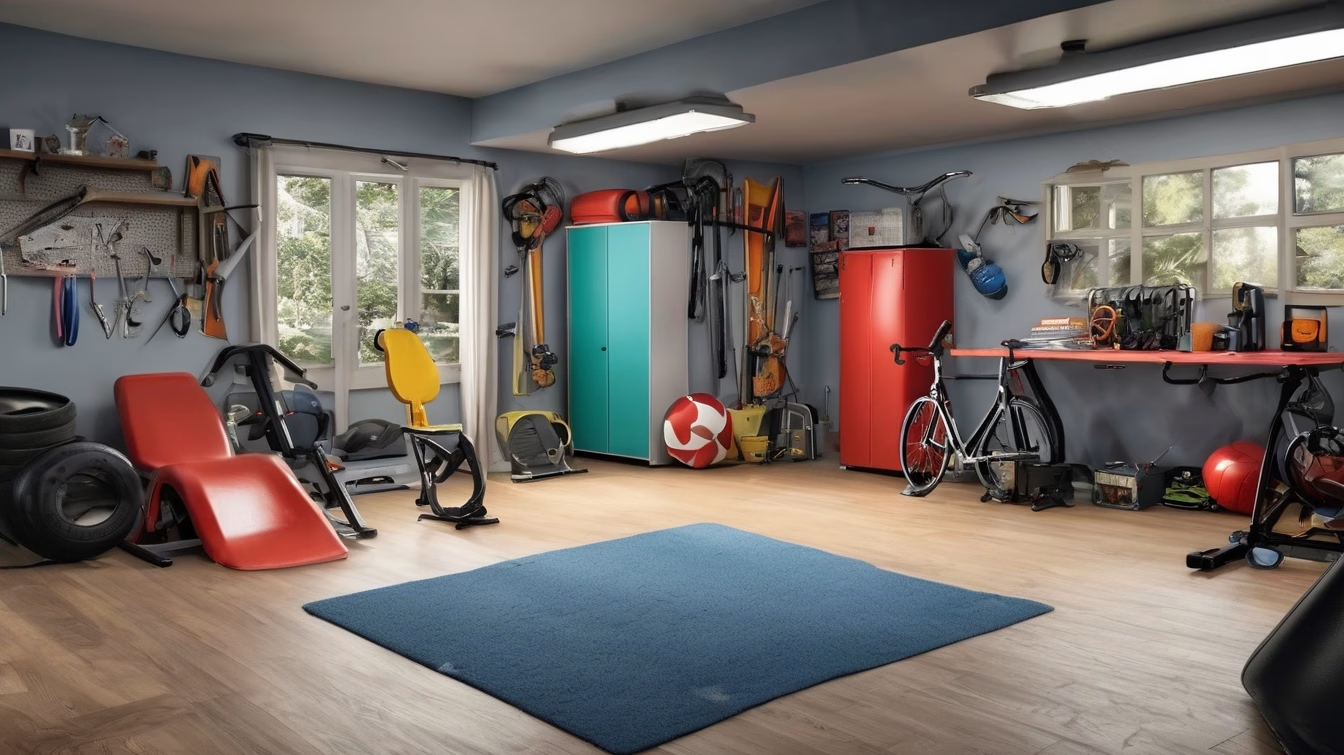Choosing the right size garage door opener is key to ensuring smooth operation, safety, and durability. The garage door opener size guide highlights that factors like door weight, material, and daily usage all play a role in determining the best fit. Whether you need a compact opener for a small door or a heavy-duty model for large commercial-style doors, this article breaks down how to match your needs with the right specifications. Learn how to avoid common mistakes and prioritize performance.
Discover how to determine garage door opener size based on measurements and requirements. This resource covers everything from calculating door dimensions to understanding power ratings and safety features. By the end, you’ll know exactly how to select an opener that aligns with your garage’s unique demands, ensuring reliability for years to come.
Understanding Garage Door Opener Sizes
Determining garage door opener size starts with matching the opener’s capacity to your door’s specifications. An improperly sized opener can strain motors, increase energy use, and create safety risks. Oversized models may overpower lightweight doors, wasting energy, while undersized units risk overheating or breaking under heavy loads.
Key factors include door dimensions, weight, and material. Insulated steel doors need stronger openers than lightweight plastic ones. Environmental conditions like heavy snow loads or extreme temperatures also affect requirements. High-traffic garages requiring frequent use demand robust systems to avoid premature wear.
Manufacturers like Chamberlain and LiftMaster offer online tools like the garage door opener size calculator. These resources guide users through measurements and specifications to recommend compatible models. Always check door weight ratings and panel type before selecting an opener to ensure compatibility.
Refer to brand sizing charts for accurate measurements. Proper sizing prevents breakdowns and maintains efficiency. Follow these steps to avoid costly mistakes and ensure smooth operation over time.
Types of Garage Doors
Choosing the right garage door opener starts with knowing your door type. Single-car doors typically measure 8 to 9 feet wide, while double-car doors span 16 to 18 feet. Double doors weigh more and require stronger openers to handle their size and surface area. Overlooking this step could lead to underpowered systems failing over time.
Material matters when selecting an opener. Steel doors are lightweight but durable, needing at least 1/2 HP motors. Wood doors, though heavier, often require 3/4 to 1 HP motors for smooth operation. Aluminum, fiberglass, and vinyl doors vary in weight, so matching opener strength to material is key to avoiding damage.
Standard residential doors range from 7 to 8 feet tall and 12 to 20 feet wide. Common sizes include 8×7, 9×7, and 16×7 configurations. Oversized doors over 20 feet wide or non-standard heights demand specialized openers to handle increased weight and torque demands. Always reference the garage door opener size guide when planning upgrades.
How to choose garage door opener size depends on these factors. Measuring door dimensions and material weight ensures compatibility. Prioritizing these details avoids common installation mistakes and ensures long-term reliability.
Power and Performance Ratings
Choosing the right garage door opener size starts with understanding horsepower (HP), a key measure of lifting power. Garage door opener motor size directly impacts performance. Most models range from 1/3 HP for lightweight doors to 1 HP+ for heavy-duty use. DC motor versions often use different ratings, focusing on amps or torque. Modern specs may list lifting force in pounds or newtons, so compare these metrics alongside HP.
Light aluminum doors work with 1/3 HP motors, while standard single-car garage door opener size pairs best with 1/2 HP. Insulated or wood doors need at least 3/4 HP. Oversized or heavy custom doors require 1 HP or higher. Match garage door opener motor size to weight: under 150 lbs uses lower HP, 200+ lbs demands stronger motors. Newer DC motors often outperform older AC models with same HP due to advanced tech.
Higher horsepower isn’t always better. Overpowering can strain door mechanisms. Check the manufacturer’s weight limits for your door type. Commercial-grade openers handle 400+ lbs but are overkill for residential use. Prioritize energy efficiency ratings when picking the right garage door opener size—look for Energy Star certifications or smart motor designs that save power without sacrificing strength. Proper sizing ensures smooth operation and extends equipment lifespan.
Drive Types and Size Considerations
Choosing the right garage door opener involves matching drive types to your door’s size and weight. The garage door opener size guide starts with understanding three main drive systems: chain, belt, and screw drives. Each has unique size requirements and performance traits.
Chain drives are durable and cost-effective, ideal for what size garage door opener do I need? calculations involving heavy doors. They handle up to 2500 lbs and work across all horsepower ranges. Their loud operation makes them best for detached garages where noise isn’t a concern. For oversized doors over 16×20 feet, chain drives often provide the required strength.
Belt drives offer quieter operation, making them a top pick for homes with living spaces above the garage. They’re suitable for doors weighing up to 2000 lbs and HP ratings between ½ to ¾. The best garage door opener size for belt models depends on balancing noise reduction with lifting capacity. Their lightweight belts may struggle with extra-wide or commercial-sized doors.
Screw drives use a centralized rail system, ideal for standard single-car garages. They support doors up to 1500 lbs and ½ HP, excelling in climates with extreme temperatures. Their compact design works well for narrower openings but may require more space for larger door widths. Installation must align the rail precisely to avoid misalignment issues.
Size limitations vary: chain drives suit largest doors, while screw drives favor moderate sizes. Always check the manufacturer’s load charts to match opener size with door dimensions. Proper alignment and torque ratings ensure optimal performance, especially for heavier configurations.
Garage Door Opener Features to Consider
Selecting the best garage door opener size involves more than just lifting power. Modern openers often include smart features like WiFi connectivity or smartphone apps, which can influence your choice. Models with voice control via Alexa or Google Home may require specific size categories, so check compatibility. These tech options don’t change physical dimensions but affect which size best suits your needs.
Safety features like auto-reverse sensors and rolling code technology are critical. Heavier doors often pair with stronger motors, which may include advanced safety systems. Rolling code encryption and backup batteries ensure reliability, especially for larger openers handling heavy doors. Always match safety tech to your garage door’s weight and opener size.
Remote control options vary by model. Systems with multiple remotes, keypads, or HomeLink integration often come in mid-to-high capacity sizes. Check how many devices your opener supports—some larger models allow pairing with up to 25 remotes. Garage door opener size calculators can help align feature needs with physical requirements.
Higher-end features like smartphone alerts or energy efficiency ratings are common in premium size categories. The best garage door opener size balances these extras with your door’s weight and track length. Review manufacturer specs to ensure features match your chosen size and performance goals.
Measuring Your Garage Door
Accurate measurements are key when determining garage door opener size. Start by measuring the door’s width and height at the top, middle, and bottom to account for any warping. Use a tape measure to record the largest dimension. For the garage door opener size calculator, note these numbers precisely. Always measure the door itself, not the rough opening, to avoid errors.
Panel thickness and weight matter too. Check the door’s material—steel is heavier than wood. If weighing isn’t possible, estimate by multiplying the door’s square footage by material density (e.g., 10 lbs/sq ft for steel). This helps match opener strength needs. What size garage door opener do I need? depends on these details.
Track and clearance requirements vary. Measure headroom—the space between the door and ceiling—typically 12–18 inches. Backroom (space behind the closed door) and sideroom (space on each side) must also meet manufacturer specs. Low-headroom models exist for tight spaces, but check compatibility with your door type.

Sketch a diagram of your garage, noting all measurements. Include track placement and overhead space. This helps compare options and ensures the opener fits your setup. Avoid assumptions—exact figures prevent costly mistakes when choosing an opener.
Installation Tips for Beginners
When installing a garage door opener, start by selecting the right size using the garage door opener size guide. Beginners should assess their comfort level with tools and the opener’s complexity. Basic setups take 2–4 hours, while heavy or custom models may require professional help. Professional installers are ideal for doors over 1,500 pounds or those needing electrical adjustments, costing $150–$300 on average.
Essential tools include screwdrivers, wrenches, and a tape measure. Larger openers may require size-specific hardware. Safety gear like gloves and goggles is mandatory. Verify measurements align with the manufacturer’s specifications to ensure the best garage door opener size for your door’s weight and dimensions. Misaligned tracks or improper torque settings can cause malfunctions.
Clear workspace and proper alignment are critical. Avoid rushing steps like securing brackets or adjusting sensors. Skipping checks for the how to choose garage door opener size specifications increases risk of errors. Always double-check door balance and opener alignment before finalizing. Regular inspections after installation maintain safety and efficiency. Proper preparation and adherence to guidelines prevent common issues like door misalignment or motor strain.
Cost Considerations for Garage Door Openers
Choosing the garage door opener motor size that fits your needs starts with understanding how size impacts cost. The best garage door opener size for your home depends on your budget and requirements. Entry-level models like the LiftMaster 8500 or Chamberlain B970 start around $200 for 1/2 HP chain drives, while 3/4 HP belt drives from brands like Genie can reach $600. Higher horsepower units, like the Chamberlain BD970, often exceed $800 for 1 HP models with quiet operation.

Price gaps widen when adding features. Wi-Fi enabled openers, such as the LiftMaster LM850.3THD, add $100–$300 to base prices. Screw drive models like the Craftsman 13953 usually cost 15–20% more than chain drives of the same horsepower. Budget shoppers should prioritize motor size over extra features—picking the right garage door opener size ensures longevity despite higher upfront costs.
Refurbished units from manufacturers like Genie often retain 80% of original warranties while cutting costs by 30%. Avoid underpowered models—even a $150 1/3 HP opener may fail prematurely on heavier doors, leading to costly replacements. Premium warranties (5+ years) typically accompany larger motor sizes, protecting investments in high-horsepower units.
Maintenance of Garage Door Openers
Regular upkeep ensures your garage door opener operates smoothly, whether you chose a small or large motor size. Follow a maintenance schedule tailored to your opener’s type and usage. For instance, larger garage door opener motor sizes often need more frequent lubrication to handle heavier loads. Check user manuals for specifics based on your model’s size and design.
Watch for signs like slow movement or loud noises, which may indicate issues linked to motor size or drive type. Belt drives require tension checks, while chain systems need cleaning. Adjust chains or belts regularly, especially for openers with larger motor sizes handling heavier doors. Test safety sensors and balance systems quarterly to prevent strain on the motor.
Annual professional inspections cost between $50–$150 and catch hidden problems. Proper maintenance extends lifespans: well-maintained openers, when paired with the correct size selection, can last 10–15 years. Prioritizing how to choose garage door opener size and ongoing care protects your investment. Align maintenance steps with your opener’s motor size and drive type to avoid premature wear. Prioritizing these steps ensures safety and reliability, reinforcing the importance of determining garage door opener size accurately from the start.















